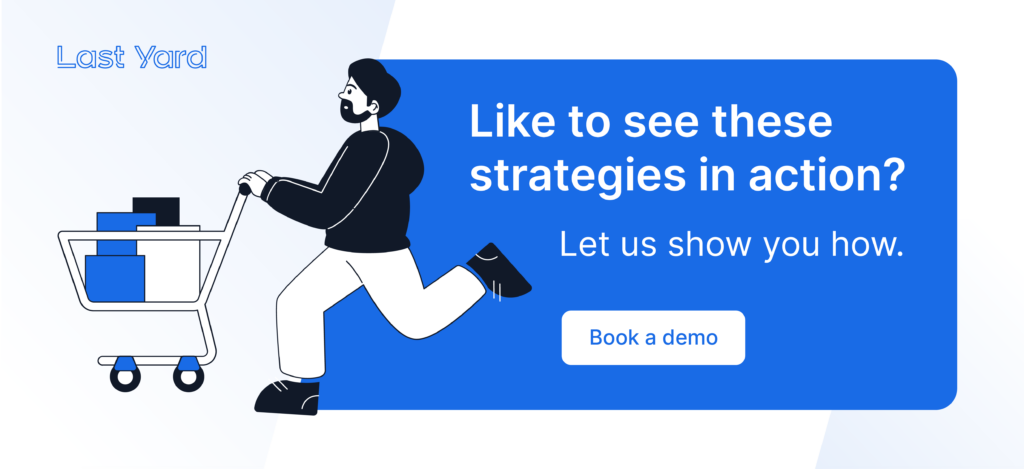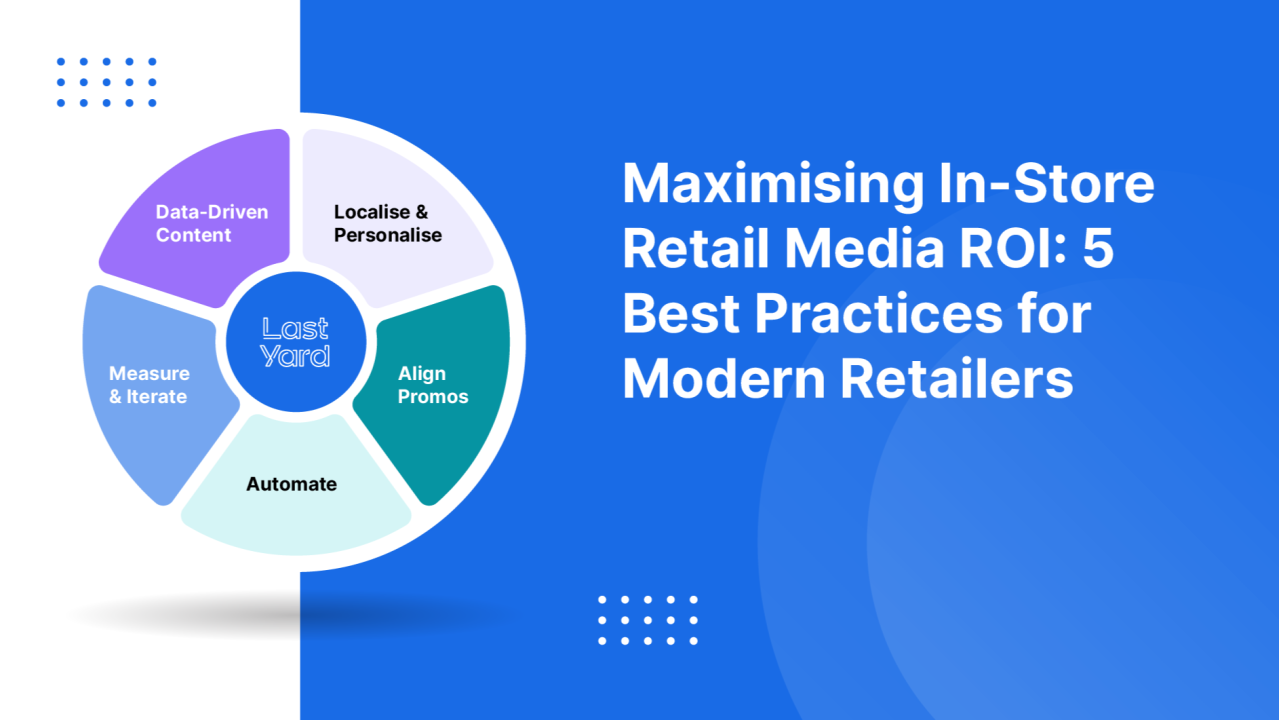In-store retail media is experiencing explosive growth, emerging as one of the fastest-rising opportunities in advertising. Retailers are rolling out digital screens, smart shelves, and other in-store touchpoints at scale, with U.S. in-store retail media ad spend projected to exceed $500 million in 2025 and top $1 billion by 2028. Industry analysts are even calling physical stores ‘the next major media channel‘ due to their massive reach and high shopper engagement.
This rapid rise brings urgency: retailers must execute in-store media well or risk missing out on its potential. After all, the store shelf is the last critical touchpoint before purchase, and done right, in-store media can significantly boost sales and brand impact. Done poorly, however, screens and signs can become underperforming assets that confuse shoppers.
At Last Yard, we believe success hinges on strategy and flawless execution, not just hardware. Below, we outline five best practices to help enterprise retailers turn in-store displays, shelf-edge screens, and store promotions into high-impact, revenue-driving assets.
1. Use Real-Time, Data-Driven Content
In-store media is most effective when it reflects the current moment. Static signage and one-size-fits-all messages are no longer enough. By connecting live data feeds, including inventory levels, pricing changes, local events, temperature, and even weather conditions, retailers can make their shelf displays and digital signs dynamic, timely, and highly relevant.
This data-driven approach ensures the content shoppers see in-aisle is always up-to-date and persuasive. For example, screens can automatically trigger urgency with tags like “Only 3 left!” when stock levels drop, or display a flash discount the instant a promotion goes live.
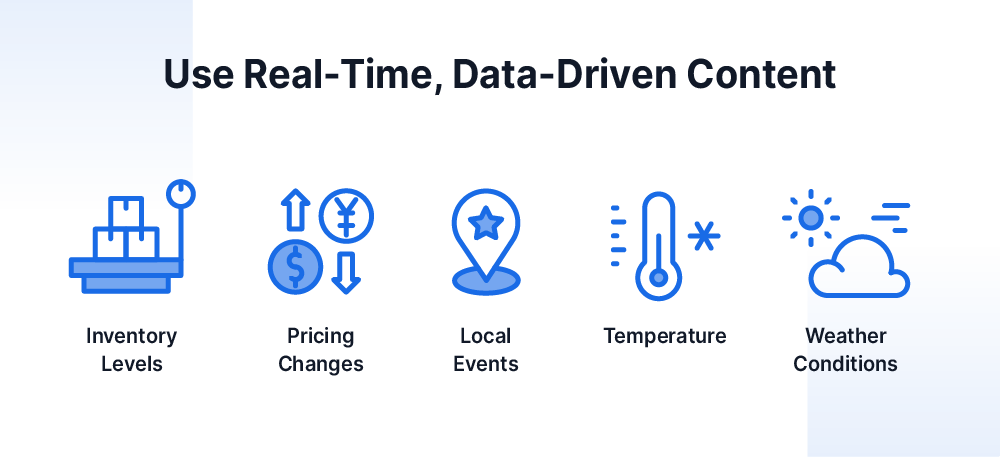
External data can also play a role. Imagine ads for hot coffee appearing on a cold morning, or smoothie promotions dominating screens during a heatwave. Modern digital signage platforms even allow content to adjust based on shopper demographics or loyalty data, such as greeting a loyalty member by name or highlighting vegan options to a plant-based shopper. These real-time adjustments bridge the gap between the promotional plan and the moment of purchase at the shelf.
They also drive results: studies show dynamic, data-driven displays significantly increase engagement and sales, with one finding a 29.5% lift in brick-and-mortar sales from digital signage deployments. In short, real-time content turns screens from static posters into reactive selling tools that respond to store conditions and shopper behaviour in the moment – an invaluable capability for enterprise retailers operating in fast-paced environments.
2. Localize and Personalize at Scale
No two stores are the same, and neither are their customers. Best-in-class retailers tailor in-store media content to each store’s local context, shopper demographics, and even individual consumer preferences. This localisation and personalisation at scale can dramatically boost engagement and conversion.
Think about regional differences: a product that sells well in one city might flop in another if it’s not locally relevant. For instance, a grocery chain can feature recipes or products that resonate with local cultural communities (e.g. highlighting kosher items in one neighbourhood and spicy sauces in another). In fact, Walgreens has tailored promotions to each store’s demographic data, such as offering deals on ethnic foods in neighbourhoods with high demand, resulting in more relevant offers and increased sales.

Personalisation can also extend to the individual level. Leverage loyalty program data and smart checkout screens to personalise the experience. Greet members by name at kiosks, display their reward points, or suggest products related to their past purchases. One real-world example is Kroger’s in-store smart screens, which aim to help shoppers make informed choices based on their individual dietary needs, health requirements, budgets, and lifestyles.
Even time-of-day personalisation makes a difference – for example, a convenience store might promote coffee and breakfast in the morning, then shift to snacks and cold drinks by the afternoon. These kinds of localised and personalised touches, applied consistently across hundreds or thousands of stores via automated templates, make the shopper feel “wow, this store understands me.”
They turn generic visits into tailored experiences and, ultimately, drive higher basket sizes and loyalty. At Last Yard, we’ve seen that even small personal touches – when scaled correctly through data and automation – can make a significant impact on conversion rates.
3. Sync Promotions with In-Store Media
Shoppers should receive a consistent message, regardless of how or where they encounter your promotion. That’s why it’s critical to synchronise your promotional campaigns with all in-store media channels – digital screens, electronic shelf labels (ESLs), printed signs, kiosks, and even store associate communications.
When a promotion or sale launches, every touchpoint in the store must convey the same message simultaneously. This consistency reinforces shopper confidence. For example, if your weekly promo is “Buy 2, Get 1 Free on Brand X,” the shelf-edge label should reflect the deal, the overhead screen should advertise it, and any handouts or endcap displays should match as well.
Nothing erodes trust faster than a mismatch – imagine a digital sign advertising 50% off while the paper shelf tag still shows full price. In fact, inconsistency between signage and pricing can directly cost sales: 42% of shoppers would abandon a purchase if the price on a screen didn’t match the shelf tag.
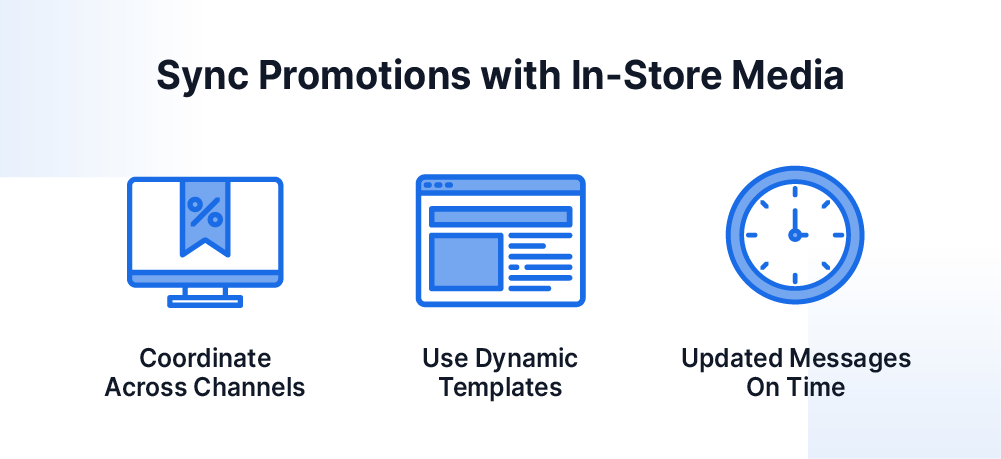
To avoid these issues, retailers are investing in systems to update content in lockstep across formats and locations. Best practices include using dynamic templates that automatically adapt creative to different formats (screen, shelf label, print) while pulling from the same data source for prices and offers.
It’s also important to sync the timing. If an online promotion or TV ad campaign starts on Friday, ensure store screens and signs update immediately when the promo begins (and deactivate as soon as it ends). This level of coordination not only prevents customer confusion, but actively builds trust and credibility – shoppers feel confident that the deal is “real” and honoured at checkout.
Consistent messaging also improves recall. A customer who sees the same promo on a website, in an email, and then again on an in-store display is far more likely to remember and act on it. In summary, aligning in-store media with your overall promotional calendar isn’t just about looking organised; it directly drives conversion by providing a seamless, trustworthy experience from advertisement to aisle.
4. Automate Execution to Drive Compliance
Even the best marketing strategy will fall flat if your stores can’t execute it accurately and on time. For large retailers with hundreds or thousands of locations, maintaining compliance and ensuring every store implements the planned signage and promotions is a perennial challenge.
Studies show that a significant portion of in-store promotions are never appropriately executed at the ground level. In one audit across 5,600+ stores in the US, the perceived compliance was more than 70%, but in reality, 42% of promotional display setups were non-compliant. The cost of these misses is high: missed signs or incorrect prices result in lost sales and unhappy customers.
The solution is to automate as much of the execution as possible. By leveraging technology to centrally push content and updates, retailers can eliminate manual errors and significantly improve speed-to-shelf. For instance, electronic shelf labels enable headquarters to update thousands of prices instantly. Carrefour reports fewer pricing errors and improved customer trust after implementing electronic shelf labels (ESLs).
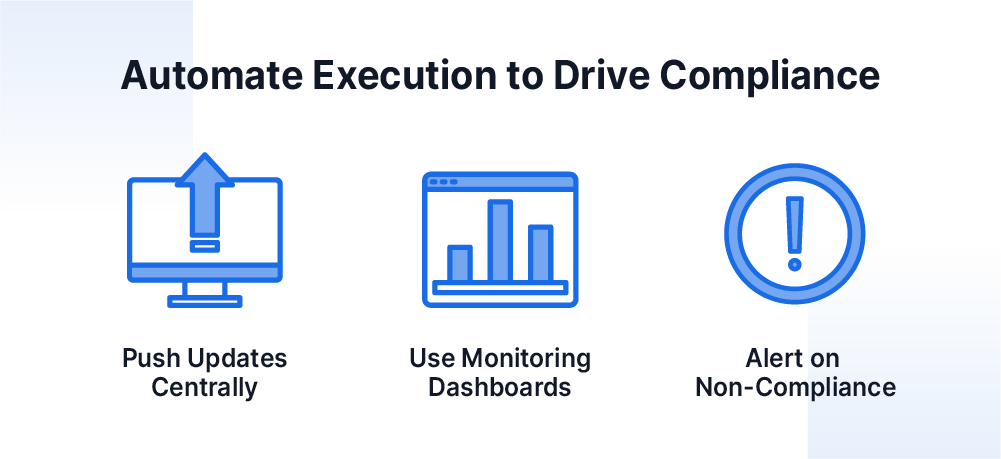
Likewise, modern content management systems can distribute a new promo creative to every digital sign across the chain at the press of a button. At Last Yard, we integrate directly with retailers’ pricing and product databases. As a result, promotions and content updates are automatically displayed on screens and shelf displays in real-time, eliminating the need for overnight print packs or manual updates from store managers.
Another key to compliance is real-time visibility. Enterprise retailers should equip themselves with HQ dashboards that track what’s live in each store. If a particular store’s screen hasn’t updated or a specific promotion hasn’t been deployed, the central team should be immediately alerted and notified to fix the issue.
Some retailers are even experimenting with IoT sensors or crowdsourced audits to verify in-store execution. The bottom line is that simplifying and automating the execution process not only reduces labour and errors but also ensures that each store reflects the correct pricing and promotions at the right time.
This consistency builds shopper trust (no more finding a promo in one store but not another) and keeps valuable CPG vendor partners happy. In an age where speed matters, automating the “last yard” of execution enables your team to focus on strategy and store experience, rather than chasing paper trails or manually updating data.
5. Measure, Test, and Iterate
The famous adage “you can’t improve what you don’t measure” holds true for in-store retail media. Treat your in-store media network with the same rigour as your digital marketing channels – by measuring performance, testing variations, and continuously optimising.
Fortunately, new technologies are making the once offline store environment much more measurable. Retailers can now link in-store media exposure with sales data, foot traffic patterns, and even shopper demographics.
Start by instrumenting your stores. For example, use point-of-sale data to track sales uplift for products featured on in-store screens versus those not featured. One major retailer found that when a promotional display was executed correctly, it generated a whopping 227% sales lift compared to stores that missed the display, yielding a $7.25 return for every $1 invested. Insights like these underscore the value of measurement.
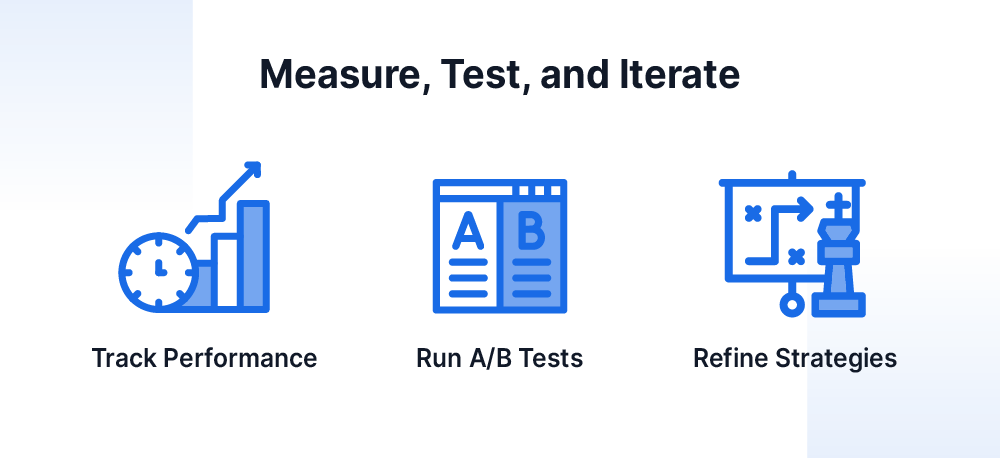
A/B testing is another powerful tool. Run one version of content (say, a price-focused ad) on some screens and a brand-focused message on others, then compare which drove more sales. If you have digital shelf screens or ESLs, you can even test different taglines or layouts in real stores. Additionally, gather qualitative feedback – what are shoppers or store associates saying about the new digital signs? Do certain messages cause confusion or delight? Every campaign is an opportunity to learn.
The goal is to iterate. Double down on approaches that show a lift, and refine or drop those that don’t. Importantly, define clear KPIs for your in-store media. These could be incremental sales, increases in basket size, dwell time near the display, or even ad revenue from brand partners. Many retailers are now integrating their in-store media into their overall retail media networks, enabling advertisers to view performance metrics.
For instance, Kroger’s new smart screen rollout is specifically designed to unlock more measurement and insight by linking in-store ads to its retail media data platform. By measuring factors such as impressions, engagement (e.g., dwell time or interactive clicks), and conversion uplift, you can present tangible ROI figures to both internal stakeholders and brand advertisers.
Ultimately, a test-and-learn culture turns your stores into a living lab for continuous improvement. Over time, this data-driven optimisation will transform your in-store media from a static expense into a strategic growth engine – one that becomes increasingly effective each quarter.
In Conclusion
In-store retail media isn’t just a shiny new initiative. It’s a competitive battleground for retailers and a key to unlocking new revenue streams. It represents that last critical moment to influence a shopper’s decision, right at the shelf. Executed well, it can boost shopper engagement, strengthen brand consistency, and drive significant sales uplift and ad revenue.
However, the difference between mediocre results and exceptional ROI comes down to mastering execution. As we often say at Last Yard, the retailers who excel in the ‘last yard’ – using real-time data, personalisation, synchronised promotions, automated compliance, and continual optimisation, will gain an edge that competitors can’t easily match.
By turning stores into responsive, data-powered media channels, you not only capture more impulse purchases and vendor dollars but also deliver a better experience for customers. In an era of rising consumer expectations and omnichannel competition, mastering in-store retail media execution is now a strategic advantage. Those who get it right will convert more visits into sales, secure stronger partnerships with brands, and ultimately drive higher ROI at the shelf–store by store, screen by screen, and dollar by dollar.
